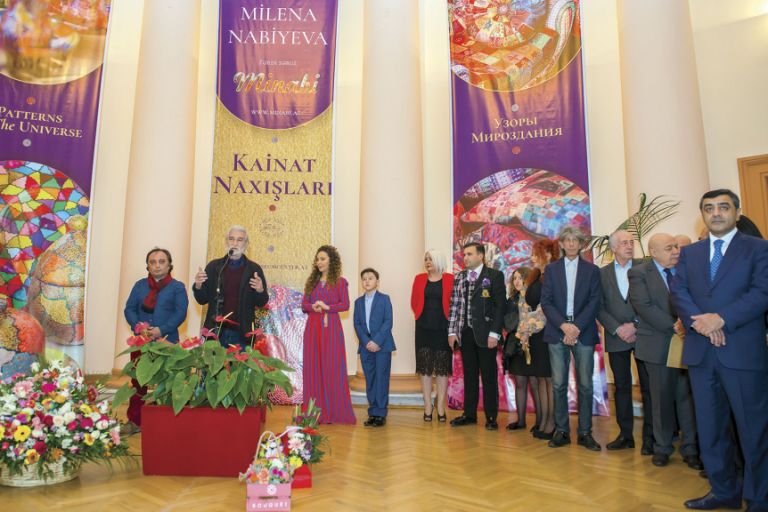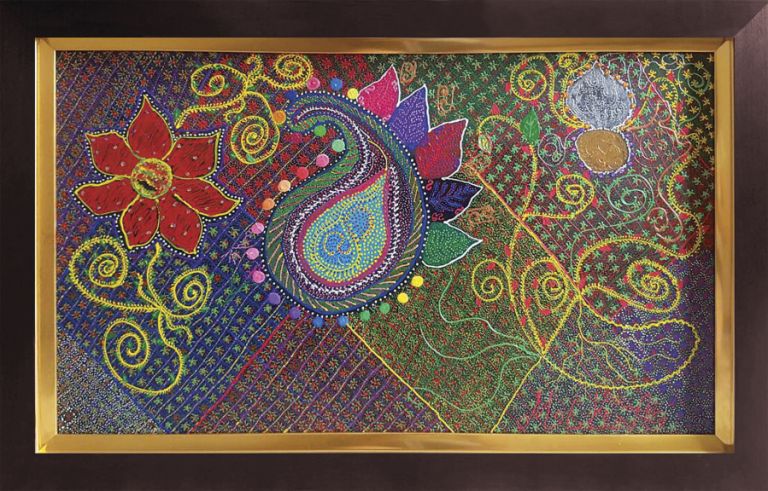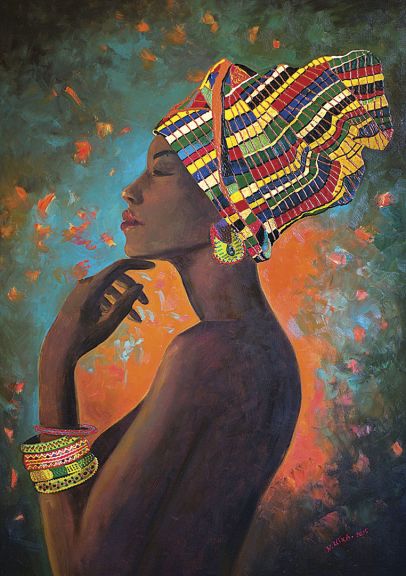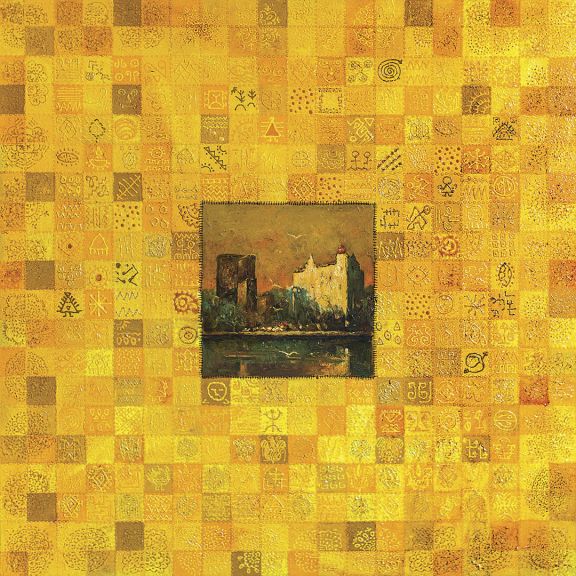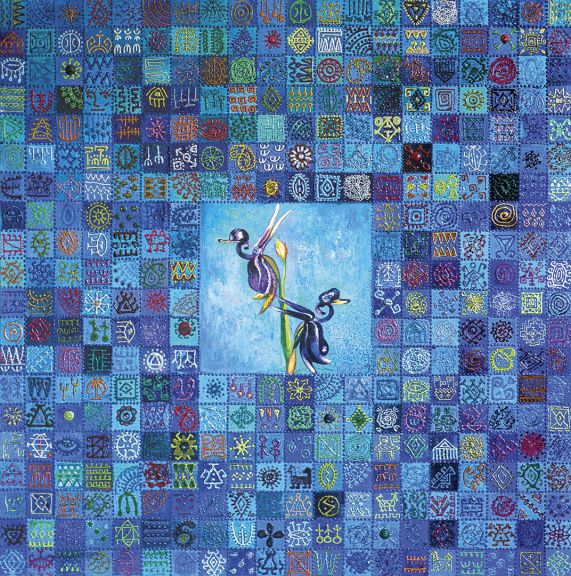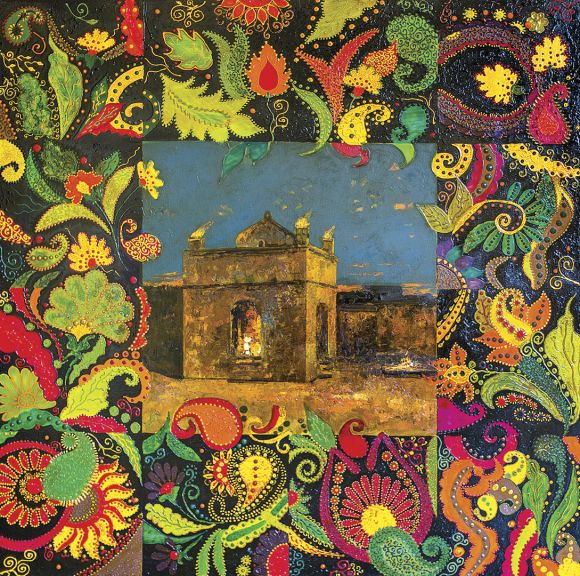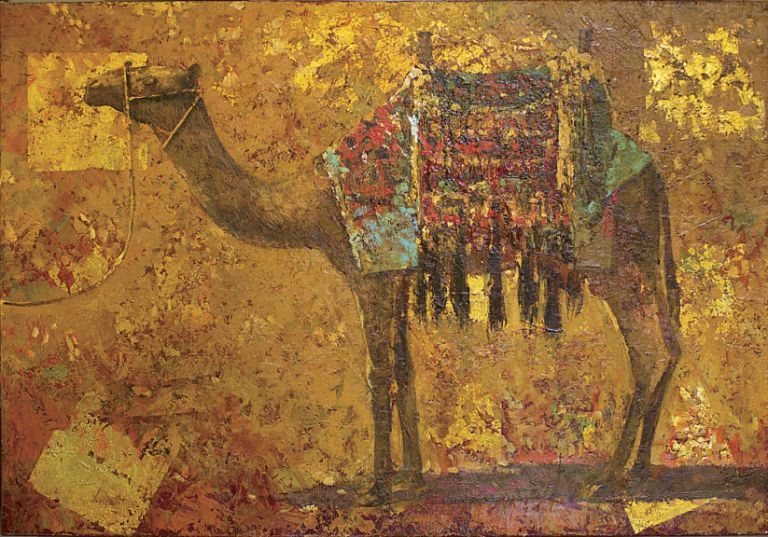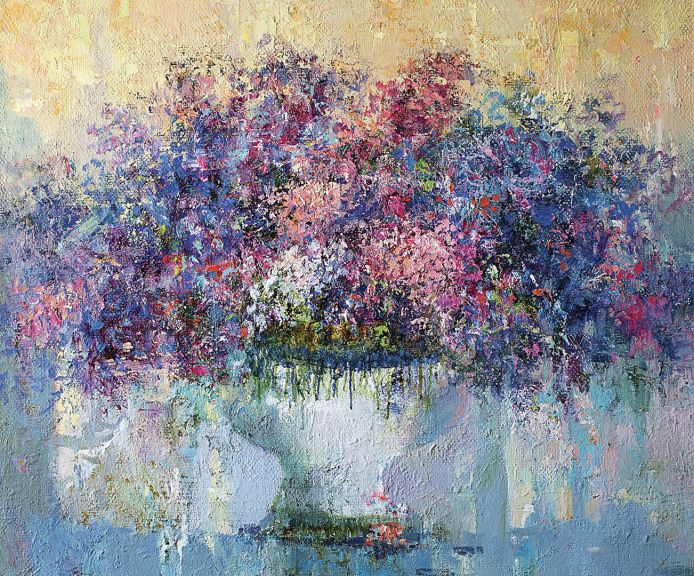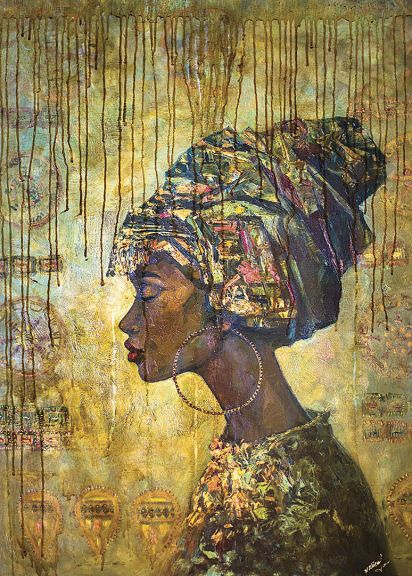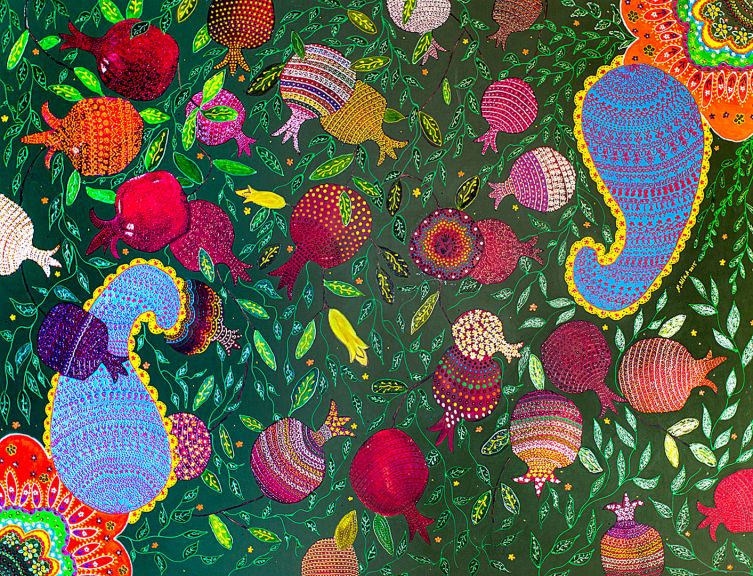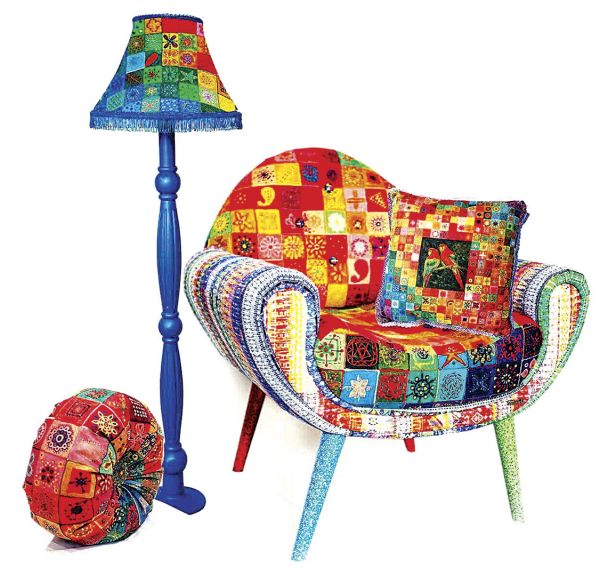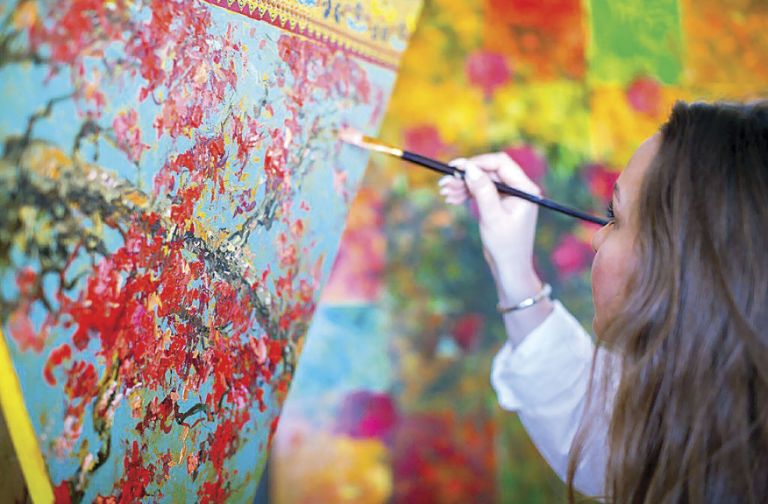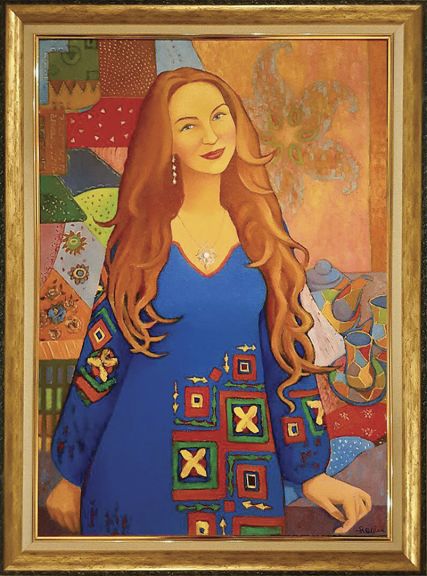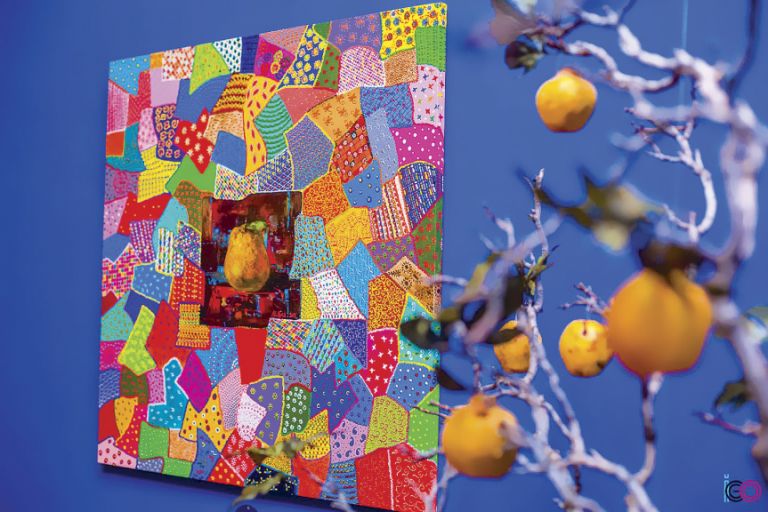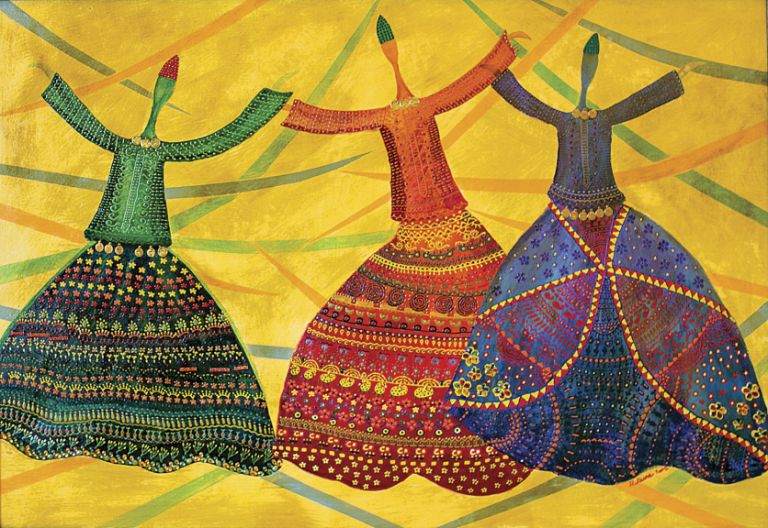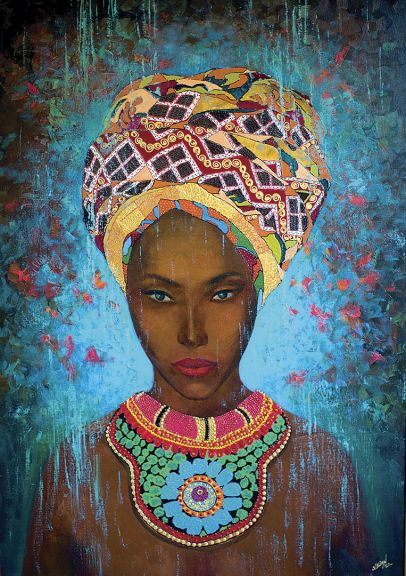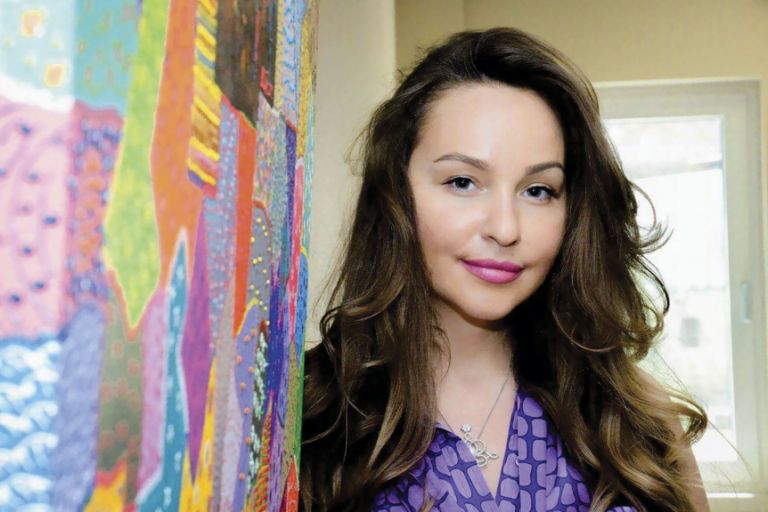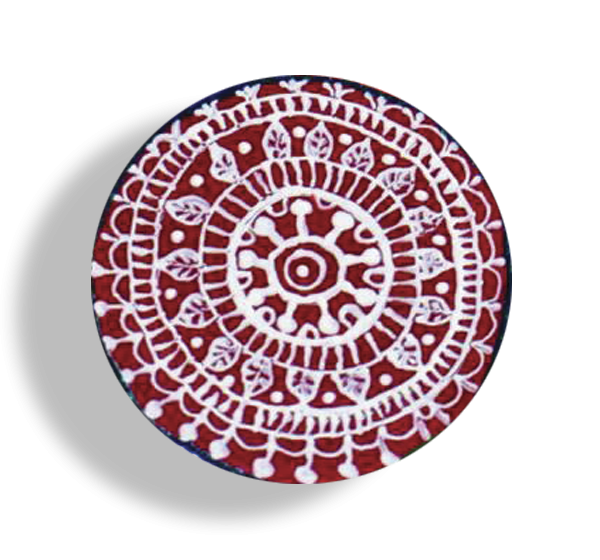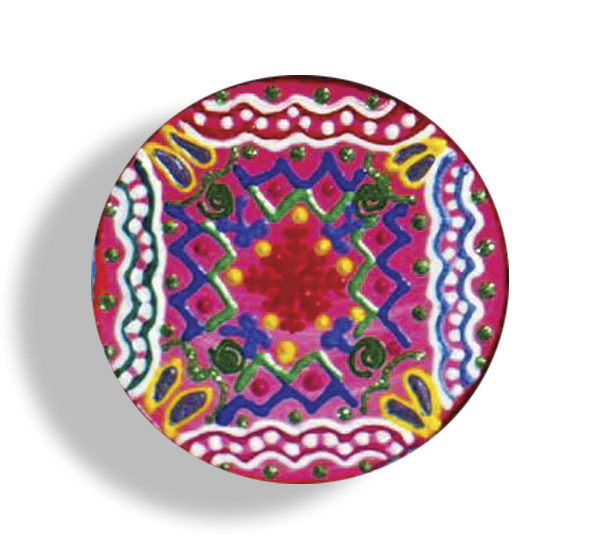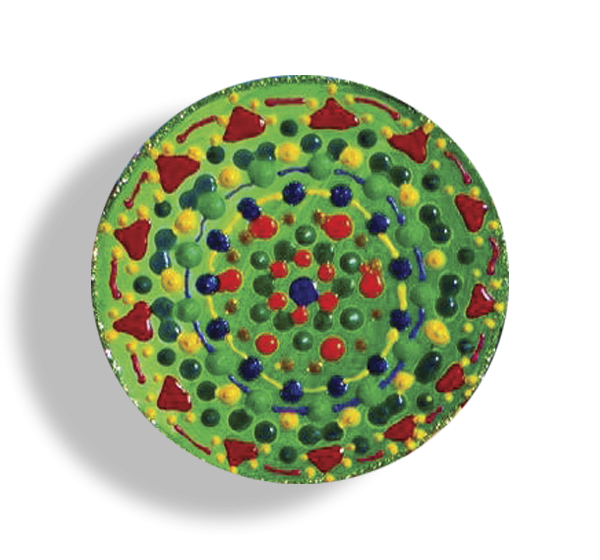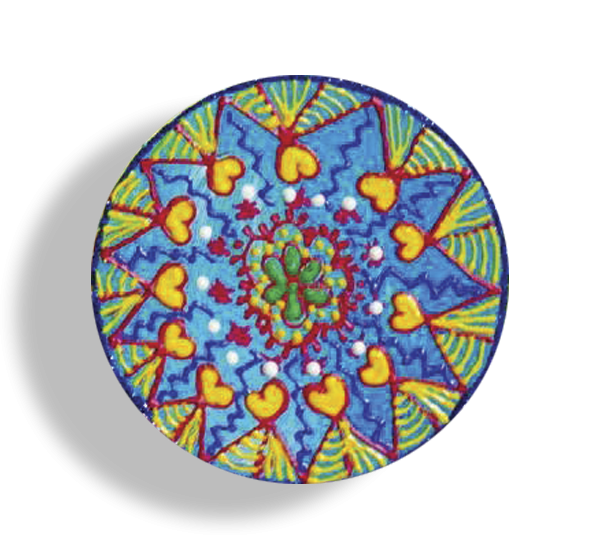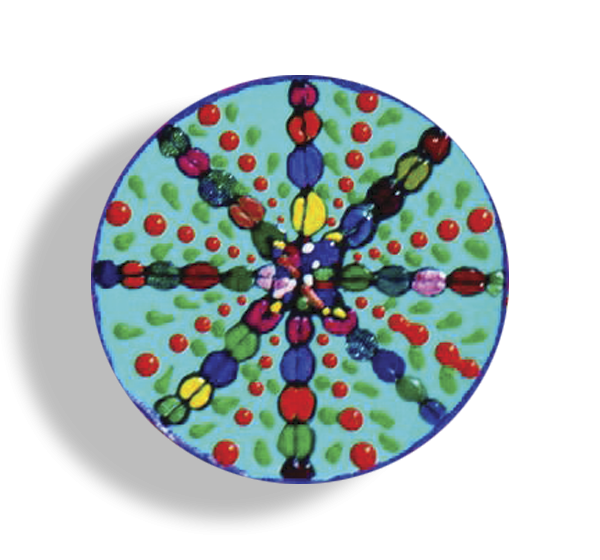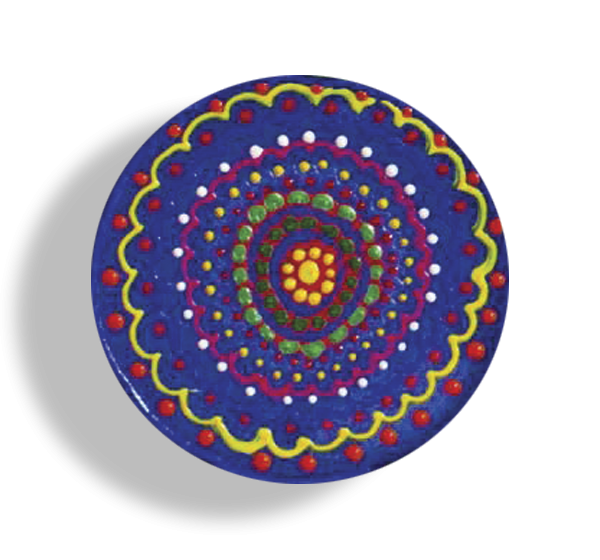Now, whenever we hear the names Nizami and Fuzuli, the first thing that almost instantaneously comes to mind is the colourful world of miniatures, a world so completely its own, that when I read that a certain young artist was continuing their legacy, my natural curiosity had to find its way to what or, better, who was behind that mysterious name. Turning to social media, which makes everything so much easier these days, just a few clicks brought me to the beautiful Milena Nabiyeva (“Mi” from Milena, “nabi” from Nabiyeva).
Born in Baku, Milena initially studied to be a pediatrician, but her early engagement prevented her from continuing her studies, since she and her husband left Baku soon after. I asked whether art had always been a part of her life. Academically, it has to a certain extent: when she was at pioneer school, there was a drawing club that she attended for about six months or so, which she had to quit due to family matters. But that did not stop the young artist:
I loved drawing during my childhood. I literally drew everywhere, on walls, in the back of all my notebooks; I was constantly scolded for that, because I even drew in books and on wooden rulers. Even my classmates remember that I drew everywhere. It was generally ornaments, faces, eyes… eyes with big lashes, I remember drawing that a lot.
Recalling her favourite drawing that she did while attending the drawing club, the picture is still vivid in her memory: I once was drawing autumn, it was a picture of nature and it was breathtaking… that picture stayed in my mind… I remember it like it was yesterday, everything in a golden colour…
Every artist has that one work that started them on their journey of creative self-exploration. And even though admirers of her talent have continuously demanded this painting be shown, Milena, with the characteristic charm and mystery of an artist, has kept her very first work a secret. Until now.
Buta, the birth
In early February, in the cozy atmosphere of the Museum Centre’s Art Gallery, Milena had her first solo exhibition entitled Patterns of the Universe. Being a tremendous personal accomplishment, it was precisely this event, she says, that brought back the timid sensations of my first steps. The time when I was standing unsure before my first “big” canvas, having a dialogue with it, the paint being my voice.Can you imagine, I haven’t touched brushes and pencils for so many years, and then all of a sudden, my mentor Subhan Mammadov tells me, “here’s the canvas and paint, go home and paint.” Taken aback, I started protesting, saying I wasn’t an artist, I couldn’t possibly paint anything, to which he said again, “you can, go on and paint.” I came home with the canvas, sat in front of it, lost at first, but then started working.
Would I want it to become a part of my exhibition? Probably not. Back then it was perceived as something akin to the intimate relationship between an author and their creation. And people are naturally interested in that first experience. As they say, “How it all began and how it all ended.”
Today, having thought through a lot that has and still is happening to me at this period of my life, I would like to finally show my personal “forerunner” in visual arts. And you know I believe that my first large-scale work deserves a personal introduction to the public.
So please welcome, Buta, the Birth.
Working process
Looking at her works, there’s certainly a mix of different techniques and knowing how strict art mentors can be, one idly wonders where and who teaches such inspiring and eye-resting freedom on canvas.My mentor, Subhan Mammadov, he teaches in the Academy, and he was the only person who directed me in visual arts or, more precisely, who gave me a correct direction in art, he taught me art. The rest, the dot technique (or pointillism), that was all me. To be honest, I haven’t studied the techniques anywhere, and my mentor always scolds me, telling me that I have to first put everything I want on paper and only then transfer it to canvas. But I bypass all the stages of drafts and sketches and always put my work on canvas first. I’m brave; I go straight into a fight with the canvas.
As to the strictness of her mentor: Subhan is first and foremost a friend to me, who tries to help me, to hear me out, to give me the right advice or direct me correctly, that’s why I’ve been with the same mentor for so long. He never speaks to me like a teacher to a student, we’re friends and understand each other with one word.
Like every creative person, and most artists for sure, sometimes Milena is not immune to moments when she wants to quit: Let’s say the painting doesn’t turn out the way I envisioned, and I want to quit painting it because the colours were off, or there weren’t any sketches and I’d already started transferring my thoughts directly onto the canvas. He can suggest to quit today… but to always come back to it tomorrow. He would always say, put the canvas away, and the next morning, when you wake up, look at it and start again with a fresh head - everything will work out. And usually it is just like he said.
As a mother of two, Milena has to plan her day accordingly. She works with oil paints in the studio during the day, while the kids are at school, and then after an entertaining evening spent with them, she comes back to the canvas at home only after midnight, when the kids are fast asleep. She says that she prefers to work when everyone is asleep and the room falls into quietness, But sometimes when I have a certain inspiration and I want to hear some music, I do put it on. Mainly classics.
Kaleidoscopic world
When I first saw Milena’s works, I thought of a kaleidoscope. And until now that impression only reinforces itself – with every turn her beautiful world unfolds one bright side after another. As any artist, she creates from inspiration and when asked where she gets it from, the answer is simple:I’m inspired by life. By my children. I’m inspired by a love of life. Every morning when I wake up, I’m alive, my kids are alive, everything is good, there are no global problems, and I feel good. Having a fresh boost of energy and strength, I’m literally filled with a positive attitude, ready to work and create. On my way to the art studio I might see a person wearing something with ornaments and I’ll remember that, even though many people don’t notice it. I can find patterns and ornaments in the shadows and remember those and rush to the studio to start a painting.
Her works attract attention and dazzle with the amount of detail and precision dedicated to every inch of the canvas. None of the paintings is done in one sitting; it takes about three to four weeks to finish one work:
But if it’s just an oil piece, not involving the dot technique, for instance the African girl paintings, it takes about a week, maybe 10 days. It depends on how well the paint dries, since some paintings require several coats of paint and then it might take longer.
Her base is always the canvas and the main materials are oil and acrylics, Swarovski stones and contours. When she gets an idea, she usually knows what materials she will be using, as she combines visual and applied arts, using acrylics and stones, which effectively makes it no longer a visual piece of art.
In principle, each of her works takes a tremendous amount of patience and painstaking precision, which has cost her eyesight dearly. As Milena mentioned earlier, she uses a lot of contours in her paintings and while working with those, as opposed to the regular painters, she cannot leave the painting vertical, because then the contour will drip. So she puts the painting on the floor, sits next to it and works in the same position for three to four weeks: Then, when everything is dry, I take it to the studio, where I start working with oil.
She signs all her works with only her initials whereas Minabi, like another turn in her kaleidoscope, is the name of the brand she created in 2013 when she began to collaborate with a firm in Turkey: she sends them the sketches of her works while they send her materials, which results in producing her own bright and unique brand of furniture.
Patterns of the Universe
Reminiscing on her recent solo exhibition, she says: To this day, it’s hard for me to characterise precisely how I felt that evening. In those three days the “fleur” of my spiritual apogee was felt the most, when my whole essence was absorbing the range of emotions from people attending. The worries and anxiety of the preparatory process had subsided. Nervousness transformed into an awareness of accomplishment. My personal accomplishment. My personal height. And the realisation of being at a corner, which I cannot wait to turn, to make new discoveries, which await me.One thing’s for sure – I’m still flying high to this day. Swimming in the ocean of colours and shades of colour and light and understanding that this “flight” is the next step in the creative quest of oneself in art.
I was preparing for a long time. I wanted to create something that would stay with people and fill them with positive thoughts, a good mood and a love of life that will linger with them long after the show. What incredible support I felt during those preparations! I should especially note the invaluable role of Liana Vezirova, who has a gift for seeing and realising the complex creative enigma that is an artist.
In terms of organisation we’ve achieved, in my opinion, a perfect result. My world was reflected ideally. To be honest I didn’t expect so many people to come. There were so many interesting artists and art figures – Tahir Mammadov, Altay Sadiqfzade, Sabina Shikhlinskaya, Arif Huseynov etc. I cannot thank everyone enough for coming and supporting me on my special day. People kept coming during all three days, and there were requests to prolong the exhibition. Unfortunately, there was another event back to back with mine, so it didn’t happen.
Hopefully, in the near future I’ll be hosting more exhibitions not only in Baku, but abroad. I love to work, I’m not afraid of hard work because as it is, my work is my favourite thing to do. Therefore I’m not working in the full sense of that word, I’m resting in the process of painting: I can forget about time and it’s already 6am and within a few hours a new day will start. It is colossal work and one has to have an incredible patience and strength to do it. And that I get from God.
Art breeds art and at the celebration of Milena’s creative journey, a certain Rahim Hashimov, a traumatology doctor but also an avid art lover and artist was also in attendance. Inspired by the bright colours and ornaments of Milena’s world, Hashimov, who not long ago presented his Modigliani-style works in his exhibition entitled Femina at the Absheron gallery, painted a portrait of Milena. The portrait is now framed, serving as a memento about this very special day, her true introduction to the world of art.
A word of advice to young artists
Attending art exhibitions whenever time allows, Milena gladly admits that art in Baku is developing at the speed of light. She doesn’t name any favourite contemporary artists, saying she likes them all and all their works:Why? Because each artist is free to express whatever they want; whatever idea appears on the canvas, be it their pain, laughter, joy or love – that is what’s lurking inside, the piece of personality they decided to share with the world. Some may not think much of that work, but some may fall in love with it. And how can you judge and deem some pretty and some not, if it’s a part of their soul on the canvas? Therefore they are all beautiful, and in order to see that, one has to look into the meaning of the work and understand the idea the artist has invested in it.
What can I say to an aspiring artist? I’ll put it this way, I haven’t worked in this field for so long and I’m not an artist in its full sense. There is one thing, however, I’d like to say: never lose hope and believe in yourself. Even if you don’t like a painting you’ve done and you think it’s not worth anything, it may in fact change somebody’s life, because some things that we see and criticise in our paintings, others see differently. So simply, believe in yourself. And these words are timeless. A tremendous power is imprinted in them. You have to believe, love and value yourself and your work. And working hard not to sell it well, but with the thought in mind that this is like your child. When you are no longer here, this will be a reminder of you, your life, your inner world. And someday, it will all be appreciated.
The most important thing you can do is love yourself, the world and people around you, and when you are filled with love from the inside, it will inevitably spill out onto the canvas in the form of incredible art. And it will be valued, inevitably.
Believe me, there are far more good people in the world than bad ones. And goodness always conquers evil. I believe in it and encourage people to do more good deeds, to think about others, and not exclusively about themselves. This goodness will come back to you threefold.
Growing up, we always heard stories about the incredibly gifted people that lived and created here, but over the years it seemed like their time had passed and that a country once so rich in artistic talent was now left with only memories. Finding people like Milena proves that talent is undoubtedly still here, in the land of wind and fire, creating, inspiring and taking people’s breath away.
After seeing most of her works, I imagine her exhibition at the Museum Centre as several rooms, floor to ceiling painted by her, decorated with stones and contours, in all her favourite bright colours, with wind chimes and pieces of coloured glass artistically hanging from the ceiling, effectively recreating the beautiful and unique, the kaleidoscopic world of Minabi.
